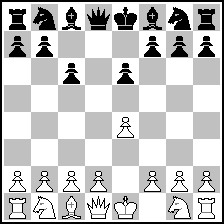|
|
| (1) Posted by Bob Baker [Sunday, Jun 4, 2023 23:16] |
Unique proof games that are not SPGs
Recently in a forum at chess.com, the question came up of what is the greatest possible move-length difference between a position's shortest unique proof game and its SPG. Below is a position with a non-unique SPG of 17.5 moves and a unique proof game of 18.0 moves. Here the length difference between the SPG and the shortest unique proof game is only one ply.
Is this a question that has been asked, or that anyone should even want to ask?
r1Rqkbnr/p2ppppp/1p2B2Q/2p3B1/R2P4/5P1N/P1PNPP1P/2KR4
|
|
| (2) Posted by James Malcom [Monday, Jun 5, 2023 00:23] |
A classic can provide a starting answer: http://pdb.dieschwalbe.de/P0000811
 (= 15+15 ) (= 15+15 )
Non-Unique Solution: 3.0
Unique Solution: 4.0
Difference: 1.0
|
|
| (3) Posted by Kevin Begley [Monday, Jun 5, 2023 04:00] |
The example given does not show a completely identical position (which might be taken as a hint for anyone who hasn't yet solved that problem).
I'm not sure that matters, but it might be interesting to consider both possibilities.
Also, it might be interesting to consider a position which, rather than a SPG, has a unique PG in exactly M moves (and also a unique PG in N moves), such that the difference in moves are maximized (M-N).
|
|
| (4) Posted by Joost de Heer [Monday, Jun 5, 2023 07:24] |
QUOTE
Also, it might be interesting to consider a position which, rather than a SPG, has a unique PG in exactly M moves (and also a unique PG in N moves), such that the difference in moves are maximized (M-N).
Maximum difference that I know of is 4.5:
https://pdb.dieschwalbe.de/P0008847
https://pdb.dieschwalbe.de/P1013079
Note that in both situations, the solution for b) is not the shortest proofgame with white to move!
The maximum known difference between two solutions where both are the shortest proofgame with a given side to move is 3.5:
https://pdb.dieschwalbe.de/P1000618
|
|
| (5) Posted by Bob Baker [Monday, Jun 5, 2023 13:44] |
In the position given by James, the shortest unique proof game has length 4.0, so the difference is 1.0. In Joost's positions, if I understand them, each twin is unique, so they don't qualify as cases where the shortest unique proof game is longer than the smallest SPG.
|
|
| (6) Posted by James Malcom [Tuesday, Jun 6, 2023 00:26] |
Bob, the position I gave can actually be an SPG in 4.5, per Per Olin's comment on PDB: 1. e3 e6 2. Bb5 Ke7 3. Bxd7 c6 4. Be8 Kxe8 5. e4
Thus, the difference is 1.5.
|
|
| (7) Posted by Joost de Heer [Tuesday, Jun 6, 2023 08:24] |
SPG is Shortest proof game, so both the 4.0 and the 4.5 moves are not SPG's.
Bob's question:
* Position A can be reached after X halfmoves with a non-unique proofgame
* Position A can also be reached after Y (>X) halfmoves in a unique proofgame (no other proofgame in Y halfmoves exists, no unique proofgames for X+1...Y-1 halfmoves).
Maximize Y-X.
The examples I gave are for a slightly different question:
* Position A has multiple unique proofgames in X1, X2 (, X3..., largest X is Xmax) halfmoves (i.e. there is exactly one proofgame in exactly X1/X2(/X3...) halfmoves). Maximize Xmax-X1.
|
|
| (8) Posted by Bob Baker [Tuesday, Jun 6, 2023 10:54] |
James, in my initial comment, I asked about maximizing the difference between the shortest proof game and the shortest unique proof game.
For the position you posted, what is the length of the shortest unique proof game?
|
|
| (9) Posted by Joost de Heer [Tuesday, Jun 6, 2023 16:06] |
QUOTE
Bob, the position I gave can actually be an SPG in 4.5, per Per Olin's comment on PDB: 1. e3 e6 2. Bb5 Ke7 3. Bxd7 c6 4. Be8 Kxe8 5. e4
Thus, the difference is 1.5.
See Bob's question:
QUOTE
what is the greatest possible move-length difference between a position's shortest unique proof game and its SPG
For the Orban position, the SPG has 3.0 moves and the shortest unique proof game has 4.0 moves. That there is also a unique proofgame in 4.5 moves is irrelevant to the question.
|
|
| (10) Posted by James Malcom [Wednesday, Jun 7, 2023 10:56] |
Ah, I see. Post edited.
|
|
| (11) Posted by Bob Baker [Wednesday, Jun 7, 2023 12:51] |
I could have shortened my initial question by asking for a position with the greatest difference between its SPG and its SUPG, except that I would then have had to answer the queries wanting to know what SUPG means, so it wouldn't have been shorter after all.
|
|
| (12) Posted by Andrew Buchanan [Wednesday, Jun 7, 2023 16:11] |
A few months ago, I added a keyword to PDB to capture a related idea. There are 25 currently: if you know more, please add.
https://pdb.dieschwalbe.de/search.jsp?expression=k%3D%27unique+p%27+AND+NOT+G%3D%27Fairies%27+AND+K%3D%27twins+length+delta%27
The largest delta is 4.5, appearing twice.
|
|
| (13) Posted by Joost de Heer [Wednesday, Jun 7, 2023 20:32] |
@Andrew: The keyword is only added for positions where both the shortest and the non-shortest are unique. Bob specifically asks for positions where the SPG is NOT unique, but a longer game is.
|
|
| (14) Posted by Andrew Buchanan [Thursday, Jun 8, 2023 03:42] |
@Joost thanks for reading more carefully than I did :-). I will edit my text.
I guess one should filter in PDB on stip='genau' or stip='exact'
|
|
No more posts |
MatPlus.Net  Forum Forum  General General  Unique proof games that are not SPGs Unique proof games that are not SPGs |
 ISC 2025
ISC 2025 Forum
Forum  General
General  Unique proof games that are not SPGs
Unique proof games that are not SPGs 


